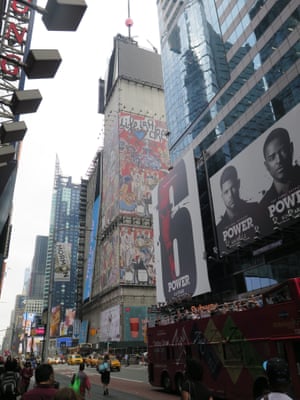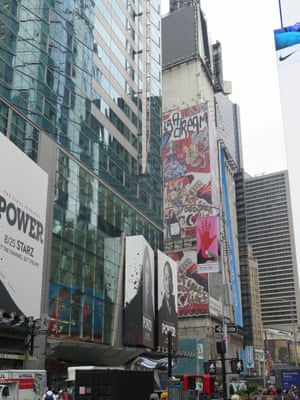[ad_1]
Times Square is not exactly a hotbed of high culture. As Fran Lebowitz once said: “If you’re a New Yorker, and you run into another New Yorker in Times Square, it’s like running into someone at a gay bar in the 1970s — you make up excuses about why you’re there.”
Now, this tourist-heavy hub in the center of midtown Manhattan is changing — it’s starting to see more art. Spanish artist Domingo Zapata has just finished painting the largest mural New York City has ever seen, hanging 300 feet high on the building at One Times Square. It took him three weeks to paint and will hang here for the next few months.
But Times Square? Really?
“I thought, ‘Let’s bring something non-commercial to the most commercial part of the world’,” said Zapata. “It’s important for people to take a few minutes and enjoy it. It’s about dreams and how everything is possible. You might see yourself in it and it might make your day more beautiful.”
Roughly 340,000 tourists plow through Times Square every day – roughly 50m visit annually – so, this isn’t exactly where one expects to find any artwork (besides the postcard landscapes, maybe, or the naked cowboy).
“That’s why we brought it here, it was about time,” said Zapata. “Even advertisements were more artistic before, now everything is data. What happened to the natural attraction to things?”

The artwork is essentially about gratitude. “Stop for a second, we’re going too fast with social media. What happened to slowing down and appreciating what’s with you, right now?” he asks. “You might enjoy it.”
The mural is covering the LED screens at One Times Square, a 25-story skyscraper owned by Jamestown, which has enormous LED walls handled by the advertising firm, New Tradition. It’s where the New Years’ Eve ball has dropped every year since 1907. This is also where it costs an upward of $1m per year to advertise.
Zapata previously did a series of video artworks last year at Times Square, before Jamestown approached him to do a bigger project. “They wanted me to paint a mural where the advertising would be, to do something different,” he said. “They thought I was the artist crazy enough to go up there.”
And it did seem a little crazy, considering he had an unexpected hitch. “The first day we got stuck up on the rig for three hours at 200 feet high and lost power, a storm was coming and our power shut down,” said Zapata. “I asked myself, ‘Why am I doing this? What was I thinking?’”
Zapata’s towering mural has hints of European modern art. It’s an expressionist romp through familiar symbols (guitars, like the ones Pablo Picasso painted), dapper men in suits (like that of Henri de Toulouse-Lautrec) and broad-stroked flowers (like the ones by Henri Matisse).
The mural stretches across 15-storys of the building, covering the west, east and south sides of One Times Square. It was created by a team of 25 people, including a handful of painting assistants. It’s not entirely painted however, some of the artwork is printed onto the vinyl.
Crank up your neck to read phrases, like “Life is a dream” and “Everybody dies but not everybody lives.”

“What I’m trying to say is, here is the most commercial, aggressively financial area in the planet, where people are go, go, go,” said Zapata. “You don’t pay attention to the fact that maybe you don’t need these big, huge dreams, but this combination of the little things and the details. Stop for a second and appreciate what you have. It will give you a big reward.”
Before it was created, the largest mural in New York City was a 20,000 square foot painting in the West Village created by Argentinian artist Magda Love alongside local high school students.
From a political video art piece by Alfredo Jaar in 1987, to the more recent video art at midnight series, Times Square billboards have seen their fair share of artwork. Recently, Studio 54 co-founder Ian Schrager took over an LED screen wrapped around the corner of 47th Street and Broadway to promote his new hotel with the Sila Sveta design studio to bring back “the sophisticated glitz and high romance” of Times Square in the 1940s.

In the months after the artwork is taken down, Zapata’s vinyl mural will be cut into 6×6 foot squares and donated to charities to support art education. Among them, he’ll donate to Pope Francis’ art education foundation, Scholas Occurrentes and Elevate, a New York organization that brings art to inner city schools.
“Art is a great therapy to understand you can make your own place in the world, your own magical place,” said Zapata. “I am trying to help others see something positive.”
Just as he painted a mural live during the Concert for Peace in Madrid this summer, Zapata is carrying on the same sort of vibe.
“I like to send a message of positive energy, no?” says the artist. “I always say, a lot of painters make a statement of what is wrong in the world, I don’t know about politics or how to make the economy better, but I know how to make it more beautiful for people who know how to make it a better place.”
“That’s my goal,” he says.
“There’s a lot to be worried about; we can’t change our world in one day, week or year, but generationally, we can little by little,” said Zapata. “Positive energy is good, but people are used to negativity. In the news, everything is a disaster but not everything is a disaster. There are beautiful things we don’t pay attention to.”
[ad_2]
READ SOURCE


